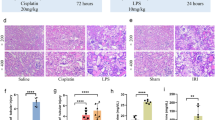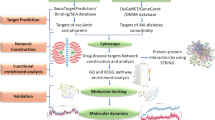Abstract
Diabetic cardiomyopathy (DbCM) is one of the most common vascular complications of diabetes, and can cause heart failure and threaten the life of patients. The pathogenesis is complex, and key genes have not fully identified. In this study, bioinformatics analysis was used to predict DbCM-related gene targets. Published datasets from the NCBI Gene Expression Omnibus with accession numbers GSE62203 and GSE197850 were selected for analysis. Differentially expressed genes (DEGs) were identified by the online tool GEO2R. Gene Ontology (GO) and Kyoto Encyclopedia of Genes and Genomes (KEGG) pathway enrichment analyses were performed using the DAVID online database. Protein–protein interaction network construction and hub gene identification were performed using STRING and Cytoscape. We used 30 mM and 1 μM hydrocortisone-stimulated AC16 cells as an in vitro model of diabetic cardiomyopathy. Quantitative real-time PCR (qRT-PCR) was performed to validate the expression levels of hub genes. A total of 73 common DEGs were identified in both datasets, including 47 upregulated and 26 downregulated genes. GO and KEGG pathway enrichment analyses revealed that the DEGs were significantly enriched in metabolism, hypoxia response, apoptosis, cell proliferation regulation, and cytoplasmic and HIF signalling pathways. The top 10 hub genes were LDHA, PGK1, SLC2A1, ENO1, PFKFB3, EGLN1, MYC, PDK1, EGLN3 and BNIP3. In our in vitro study, we found that PGK1, SLC2A1, PFKFB3, EGLN1, MYC, EGLN3 and BNIP3 were upregulated, ENO1 was downregulated, and LDHA was unchanged. Except for PGK1 and ENO1, these hub genes have been previously reported to be involved in DbCM. In summary, we identified DEGs and hub genes and first reported PGK1 and ENO1 in DbCM, which may serve as potential candidate genes for DbCM targeted therapy.







Similar content being viewed by others
Data Availability
The open-access datasets are available through the following URL: GSE62203 (https://www.ncbi.nlm.nih.gov/gds/?term=GSE62203) and GSE197850. (https://www.ncbi.nlm.nih.gov/gds/?term=GSE197850). All data generated or analyzed during this study are available from the corresponding author on reasonable request.
Abbreviations
- DbCM:
-
Diabetic cardiomyopathy
- DEGs:
-
Differentially expressed genes
- GEO:
-
Gene Expression Omnibus
- GO:
-
Gene Ontology
- hi-PSCs:
-
Human induced pluripotent stem cells
- hiPSCs-CMs:
-
Human induced pluripotent stem cell-derived cardiomyocytes
- KEGG:
-
Kyoto Encyclopedia of Genes and Genomes
- PPI:
-
Protein–protein interaction
References
Ibrahim E-SH, Dennison J, Frank L et al (2021) Diastolic cardiac function by MRI-imaging capabilities and clinical applications. Tomography 7:75
Avagimyan A, Popov S, Shalnova S (2022) The pathophysiological basis of diabetic cardiomyopathy development. Curr Probl Cardiol 47(9):101156
Tadic M, Cuspidi C, Calicchio F et al (2020) Diabetic cardiomyopathy: how can cardiac magnetic resonance help? Acta Diabetol 57:1027–1034
Kumric M, TicinovicKurir T, Borovac JA (2021) Role of novel biomarkers in diabetic cardiomyopathy. World J Diabetes 12:685–705
Chua CJ, Morrissette-McAlmon J, Tung L et al (2023) Understanding arrhythmogenic cardiomyopathy: advances through the use of human pluripotent stem cell models. Genes (Basel) 14(10):1864
Fujiwara Y, Miki K, Deguchi K et al (2023) ERRγ agonist under mechanical stretching manifests hypertrophic cardiomyopathy phenotypes of engineered cardiac tissue through maturation. Stem Cell Reports S2213–6711(23):00362–00364
Purnama U, Castro-Guarda M, Sahoo OS, Carr CA (2022) Modelling diabetic cardiomyopathy: using human stem cell-derived cardiomyocytes to complement animal models. Metabolites 12(9):832
Onódi Z, Visnovitz T, Kiss B, Hambalkó S, Koncz A, Ágg B et al (2022) Systematic transcriptomic and phenotypic characterization of human and murine cardiac myocyte cell lines and primary cardiomyocytes reveals serious limitations and low resemblances to adult cardiac phenotype. J Mol Cell Cardiol 165:19–30
Linscheid N, Santos A, Poulsen PC, Mills RW, Calloe K, Leurs U et al (2021) Quantitative proteome comparison of human hearts with those of model organisms. PLoS Biol 19(4):e3001144
Li H, Li X, Guo J, Wu G, Dong C, Pang Y et al (2020) Identification of biomarkers and mechanisms of diabetic cardiomyopathy using microarray data. Cardiol J 27(6):807–816
Wang JY, Ma D, Luo M, Tan YP, Ou Zhong, Tian G, et al. Effect of spermidine on ameliorating spermatogenic disorders in diabetic mice via regulating glycolysis pathway. Reprod Biol Endocrinol. 2022;20(1):45.
Ng KM, Lau YM, Dhandhania V, Cai ZJ, Lee YK, Lai WH et al (2018) Empagliflozin ammeliorates high glucose induced-cardiac dysfunction in human iPSC-derived cardiomyocytes. Sci Rep 8(1):14872
Pilkis S, Claus T, Kurland I, Lange A (1995) 6-Phosphofructo-2-kinase/ fructose-2,6-bisphosphatase: a metabolic signaling enzyme. Annu Rev Biochem 64:799–835
Cavalier MC, Kim SG, Neau D, Lee YH (2012) Molecular basis of the fructose-2,6-bisphosphatase reaction of PFKFB3: transition state and the C-terminal function. Proteins 80:1143–1153
Hou N, Mai Y, Qiu X, Yuan W, Li Y, Luo C et al (2019) Carvacrol attenuates diabetic cardiomyopathy by modulating the PI3K/AKT/GLUT4 pathway in diabetic mice. Front Pharmacol 12(10):998
Atawia RT, Batori RK, Jordan CR et al (2023) Type 1 diabetes impairs endothelium-dependent relaxation via increasing endothelial cell glycolysis through advanced glycation end products, PFKFB3, and Nox1-mediated mechanisms. Hypertension 80(10):2059–2071
Song C, Wang S, Fu Z et al (2022) IGFBP5 promotes diabetic kidney disease progression by enhancing PFKFB3-mediated endothelial glycolysis. Cell Death Dis 13(4):340
He Y, Wang X, Lu W, Zhang D, Huang L, Luo Y et al (2022) PGK1 contributes to tumorigenesis and sorafenib resistance of renal clear cell carcinoma via activating CXCR4/ERK signaling pathway and accelerating glycolysis. Cell Death Dis 13(2):118
Li X et al (2016) Mitochondria-translocated PGK1 functions as a protein kinase to coordinate glycolysis and the TCA cycle in tumorigenesis. Mol Cell 61:705–719
Zuo J, Wang B, Long M, Gao Z, Zhang Z, Wang H et al (2018) The type 1 transmembrane glycoprotein B7–H3 interacts with the glycolytic enzyme ENO1 to promote malignancy and glycolysis in HeLa cells. FEBS Lett 592(14):2476–2488
Chen JX, Stinnett A (2008) Ang-1 gene therapy inhibits hypoxia-inducible factor-1alpha (HIF-1alpha)-prolyl-4-hydroxylase-2, stabilizes HIF-1alpha expression, and normalizes immature vasculature in db/db mice. Diabetes 57(12):3335–3343
Xia Y, Gong L, Liu H, Luo B, Li B, Li R et al (2015) Inhibition of prolyl hydroxylase 3 ameliorates cardiac dysfunction in diabetic cardiomyopathy. Mol Cell Endocrinol 5(403):21–29
Zhou W, Yang J, Zhang DI, Li F, Li G, Gu Y, Luo M (2015) Role of Bcl-2/adenovirus E1B 19 kDa-interacting protein 3 in myocardial cells in diabetes. Exp Ther Med 10(1):67–73
Rami M, Rahdar S, Ahmadi Hekmatikar A, AwangDaud DM (2023) Highlighting the novel effects of high-intensity interval training on some histopathological and molecular indices in the heart of type 2 diabetic rats. Front Endocrinol (Lausanne) 19(14):1175585
Zhao C, Shen Q (2018) Overexpression of small ubiquitin-like modifier 2 ameliorates high glucose-induced reductions in cardiomyocyte proliferation via the transforming growth factor-β/Smad pathway. Mol Med Rep 18(6):4877–4885
Zhou W, Yang J, Zhang DI, Li F, Li G, Gu Y et al (2015) Role of Bcl-2/adenovirus E1B 19 kDa-interacting protein 3 in myocardial cells in diabetes. Exp Ther Med 10(1):67–73
Lin G, Brownsey RW, Macleod KM (2014) Complex regulation of PKCβ2 and PDK-1/AKT by ROCK2 in diabetic heart. PLoS ONE 9(1):e86520
Acknowledgements
None.
Funding
This work was supported by National College Students' Innovative Entrepreneurial Training Plan Program (202210062018), CAMS Innovation Fund for Medical Sciences (CIFMS) (approval No. 2021-I2M-1–073, 2022-I2M-C&T-B-091), Tianjin Natural Science Foundation (approval No. 20JCZDJC00410, TJWJ2022MS001), Sansheng TCP Young Research Funding (approval No. 57) and National Natural Science Foundation of China (approval No. 82170217, 82070192, 81670171).
Author information
Authors and Affiliations
Contributions
Shuo An, Hongchen Bi and Xiaoli Luo wrote the main manuscript text. Caiying Zhu and Min Wang prepared Figs.1-7. All authors read and approved the final manuscript.
Corresponding authors
Ethics declarations
Competing interests
The authors declare that they have no competing interests.
Consent for publication
Not applicable.
Ethical approval and consent to participate
Not applicable.
Additional information
Publisher's Note
Springer Nature remains neutral with regard to jurisdictional claims in published maps and institutional affiliations.
Supplementary Information
Below is the link to the electronic supplementary material.
Rights and permissions
Springer Nature or its licensor (e.g. a society or other partner) holds exclusive rights to this article under a publishing agreement with the author(s) or other rightsholder(s); author self-archiving of the accepted manuscript version of this article is solely governed by the terms of such publishing agreement and applicable law.
About this article
Cite this article
An, S., Bi, H., Luo, X. et al. Identification of key genes of diabetic cardiomyopathy in hiPSCs-CMs based on bioinformatics analysis. Mol Cell Biochem (2024). https://doi.org/10.1007/s11010-023-04915-9
Received:
Accepted:
Published:
DOI: https://doi.org/10.1007/s11010-023-04915-9




